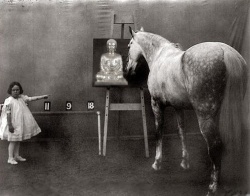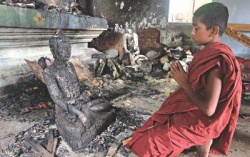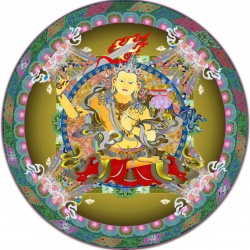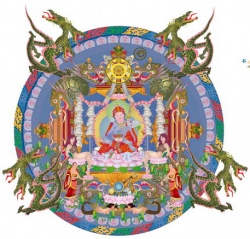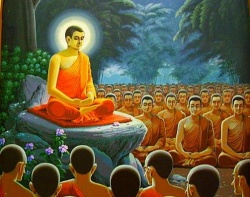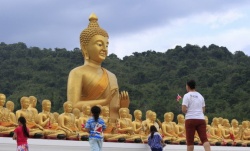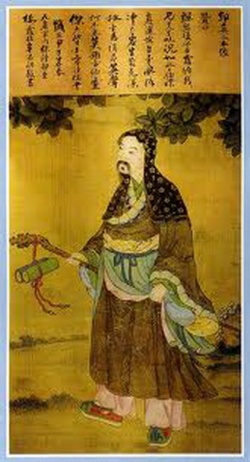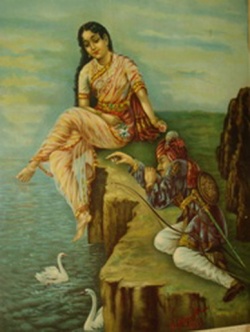The Monastic Quest:
Throughout Buddhist history, serious monastic practitioners have devoted themselves both to learning and scholarship and to the disciplines of meditation. Although some have placed particular emphasis on one or the other, most have pursued their spiritual quest by combining these two different approaches according to their own distinctive needs, capabilities, and traditions.
For many of the most committed monks and nuns, the spiritual quest has extended over a lifetime and has been embedded in a variety of communal contexts. Among these communal contexts, two have special importance. For monks and nuns, pilgrimages to sacred places associated with Buddhas, bodhisattvas, and/or other Buddhist deities and saints have constituted important occasions for receiving inspiration, expressing devotion, and cultivating understanding and personal introspection. More extended visitations to various temples, monasteries, and hermitages have also played a crucial role. These visitations have provided the occasion and context for receiving instruction from many learned scholars, for becoming acquainted with a significant number of important religious texts, and for being introduced to a variety of different meditative rituals and techniques.
The following biographical account, presented by Hanna Havnevik, of a Tibetan nun illustrates the varied, cumulative, and often peripatetic nature of the Buddhist monastic quest, as well as the communal contexts 110 MONASTIC PRACTICES
1. Editorsf note: Dharamsala, a city in northern India, has become a major center for Tibetan refugees who have fled from the Chinese invasion of their homeland. within which it takes place. Tibet has historically been an environment pervaded by esoteric trends and traditions.an environment particularly conducive to seeking out individual teachers who are thought to possess special supranormal powers and who can offer distinctive types of ginitiationsh or gordinations.hHowever, despite these idiosyncrasies, the nunfs biographical trajectory shares a number of general features with the biographical trajectories of many deeply committed monks and nuns living in many different Buddhist cultures.
One of these features is her sustained exposure to Buddhist teachings, practices, and role models as a child and young adult. Another shared feature is her persistent pursuit of religious knowledge and experience, even in the face of serious social and cultural disruption.
Hanna Havnevik
The nun Yeshe Drolma is known by Tibetans in Dharamsala to be a very good meditation practitioner.1 In fact she is called gomchen which means great meditator. Tashi Tsering arranged for me two meetings with her, which each time lasted for several hours. Yeshe Drolma had agreed to tell me the story of her life and this is how she herself wanted to tell about her life and her religious practice. I am greatly indebted to Tashi Tsering for the translation of this interview.
The time I spent with the nun Yeshe Drolma made a great impression on me. We visited her in the end of December 1983, and there was a very good atmosphere in her small room (about two by three meters). In her room there was a bed, a kerosene stove, and a beautiful altar, with all the necessary ritual objects and pictures of bodhisattvas, dakinis (a class of female goddesses), and lamas (respected religious leaders in the Tibetan Buddhist context) that have been important to her. Yeshe Drolma constantly offered us Tibetan tea, biscuits and sweets. She all the time kept saying that her story was not worth recording, that she was only one religious practitioner among several others. She kept stating that she has not been doing any great things in her life. I was born in 1908, in the Tibetan Earth Ape Year, at Sangshung
2. Editorsf note: Lhasa is the capital of Tibet. 3. Editorsf note: Milarepa is a famous Tibetan saint who lived during the eleventh and twelfth centuries.
4. Editorsf note: Tara is a female deity who plays an important role in the Tibetan Buddhist pantheon.
5. Editorsf note: Rinpoche may be translated as gprecioush or gvery precioush and is a term of respect especially reserved for those who are considered to be reincarnate lamas. 6. Editorsf note: Mani mantras are gseed mantrash associated with particular deities in the Tibetan Buddhist pantheon.
Shodrug north of Lhasa.2 The nomad tribe my family belonged to was called Surug. Surug is the name of one of the six nomad tribes of Sangshung. My fatherfs name was Tender and my mother was named Karmo. We were nine children in our family and I was the youngest. gOur family was well-to-do and we were very religious people. Constantly there were three monks employed to recite sutras and tantras in our home. One of these monks was called Nelchorma and during his employment he read Milarepafs biography, the hundred thousand songs of Milarepa, and the text Thardo one hundred times each year.3 He also recited the twenty-one Tara prayer seventeen hundred thousand times.4 Since he was always reciting, he never had time to talk. When I was young, very few women in the northern region of Tibet learnt reading and writing. I was lucky to have Nelchorma as my first teacher, and thus it was he who opened for me the door to spiritual life. gMany lamas were invited to our home.
I only remember the names of the most important ones, which were: Taglung Shabdrung Rinpoche, Matrul Rinpoche, and Tsetrul Rinpoche.5 I was too young at the time to understand their religious teachings, but I received initiations from them all. Matrul Rinpoche gave me the name Yeshe Lhatso. gMy parents took me to Lhasa twice, when I was nine and when I was thirteen years old. After returning from Lhasa the second time, I did a pilgrimage, circumambulating Namtsho, a lake north of Lhasa. Back at home I did an offering-prayer. I recited mani mantras one hundred thousand times and I started doing morning prostrations, one hundred at a time.6 This I have done every morning since. gWhen I was about thirteen years old, I started going to the meadows and pray to the Buddhas in the four directions. I asked that I may live a spiritual life and not the life of a laywoman. I feared this as I saw that my elder sisters were being sent off in marriage to different tribes. Suitors had already asked me to marry, but I refused. They did not ask me because I was particularly pretty, but because I came from a wealthy family, and my father was well known in the area. My brothers and sis1
7. According to Tibetan belief, when a religious practitioner recites certain mantras one hundred thousand times, he or she grows a new tooth, called dungso. 8. Editorsf note: Mt. Kailash is a sacred mountain located in western Tibet. ters were having successful marriages, and thus they thought me to be a desirable partner.My family asked the suitors to wait until I was twenty years old, as they thought that I would have changed my mind by then. gWhen I was fifteen years old, I did one hundred and thirteen circumambulations of Tshepag Lhakang in Lhasa. Two years later, I did one thousand seven hundred prostrations while circumambulating three stupas called Taglung Kumbum in Taglung Monastery north of Lhasa. gWhen I was seventeen years old, my mother died (1924). My father now decided to do a retreat for three years. When the three years were up, he started another retreat called sealed-door retreat.
Each day he did four sessions of meditation and prayer.He stayed in the retreat for twelve years, and died in the cave during a fourth meditation session. He was reciting Vajra Guru Mantra of Padmasambhava (a very important Buddhist saint ca. the 8th century who is believed to have contributed to the conversion of Tibet by quelling local demons), and before he died a small new tooth grew in his mouth.7
gThere was another outstanding religious person in my family who inspired me much. This was my younger uncle. He was sent to his inlawfs house, and his wifefs family made him work very hard. They did not give him any free time for religious practices. During work he used to recite mani mantras. He had a pocket hanging around his neck, and when he had finished one hundred mantras, he put a pebble in the pocket. Then, in the evening, in candlelight or in the shade of the moon, he counted the pebbles and changed them into beads. Thus he was able to count the mantras he recited, and in this way he counted one hundred million mani mantras. As time passed he was given more rights in the household, and he could do his prayer and visualization sessions without being interrupted. Altogether he recited six hundred million mani mantras.
gOne of my elder sisters had been a nun from when she was eight years old. Her name was Peldzom Drolma. She, together with a friend, meditated in Tongshong Phugpa, a cave near Phumdo. They were followers of the Kagyu tradition and their teacher was Gangshar Rinpoche. In 1925, partly to avoid being married, I joined my sister Peldzom Drolma, a nun called Sangmo Chodon, and her mother on a long pilgrimage to Mt. Kailash.8
On the way we visited many holy places, such as Tashilunpo MonTHE
9. Editorsf note: The Thirteenth Dalai Lama was the head of the Buddhist theocratic state that ruled Tibet at the time. His successor, the Fourteenth Dalai Lama, is presently the leader of the Tibetan community in exile.
astery, Sakya Monastery, Dingri Monastery, and Shelkar Monastery. In Mustang we visited pilgrimage sites such as Sala Mabar, Dola Mebar, and Chumig Gyatsa. On our trip we also went to Purang and saw the images Khorchag Jowo and Namkha Khyungdzong. Here I met the famous Lama Degyel Rinpoche. Now I undertook my first haircutting ceremony, and Degyel Rinpoche looked in the scriptures he was reading and gave me the name Drolma Yangchen. I received religious teachings from Lama Degyel, but I do not remember which.
gOur pilgrimage lasted for one year and three or four months. During all this time we did not waste one day, we were always receiving religious teachings from lamas or visiting holy places. I do not remember the names of all the sacred sites, but we visited them all in the western region of Tibet. I came back to my tribe in 1926, then nineteen years old. The spiritual master of my father, Potrul Rinpoche Karma Yinpa Dargye from Dzigar Monastery in Kham, told me that he had done the same pilgrimage, and that it was equal to seven preliminary practices. gIn order to obtain religious teachings from Potrul Rinpoche, I did the preliminary practice called Chagchen Ngondro. This religious practice consists of one hundred thousand prostrations, one hundred thousand prayers of refuge, reciting one hundred letters or mantras one hundred thousand times, then one hundred thousand mandal, and finally Guru prayers one hundred thousand times.
gIn the following years I continued doing my religious practice as before. In 1928 I went to Lhasa and twice circumambulated the Lingkor, and I did one circumambulation with prostrations around the Bamye, the Radre, and Drigung Thil. Three times Iwent on pilgrimage to Bumri Barkor. When I was twenty-three years old (1930), I was ordained a novice by Potrul Rinpoche, and given the name Tshultrim Palmo. gMy fatherfs guru, Potrul Rinpoche, had been to many pilgrimage places all over Tibet and received religious instructions from different teachers. He was destined to have a monastery somewhere, and he had looked all over Tibet for a proper place. While staying with our tribe, he found the place he had been searching for. He reported this to the Thirteenth Dalai Lama, who shared his aspirations and allowed him to found a monastery.9 The monasteryfs name, Thosam Changchub Ling, was given by the Thirteenth Dalai Lama. The monastery was situated in the south of Surug, and it was of the Drugpa Kagyu School.
At that time (1935 .1936) Kunsang and I decided to build a hermitage. Kunsang came from a poor family and was a distant relative of mine. Our families supported us during our building project, and our brothers helped us with the work. The hermitage was to be a sub-branch of Thosam Changchub Ling and it was situated ca. twenty minutes walk north of the monastery. The hermitage was generally known by the name of Dragkhu. At first we had only three rooms, but the hermitage expanded as we were joined by eighteen to twenty more nuns. In the daytime we went to the main monastery for religious teachings and came back to our hermitage after dark.
gFrom 1935 to 1958 Kunsang and I stayed most of the time at Dragkhu. Sometimes during these twenty-two years of hermit life, my family sent a horse for me so that I could come and visit them. This usually happened during the summer.Otherwise, I spentmytimeat Dragkhu. Some of the winters I followed my nephew Changchen Khentrul Rinpoche to Drigung Monastery. At Drigung I stayed for some time to receive religious teachings and to visit pilgrimage sites.
gIn Drigung there is a place called Tshaphug and here I obtained religious teachings on Tara from Lama Dorje Lhokar. In Terdrom I received the initiation of Vajrakila, and Nyentshe. I recited certain seedsyllables one hundred thousand times. I also recited one hundred thousand seed-syllable mantras to Vajrakila. In Dringung Thil, I did ten periods of fasting, each period lasting for twenty days. Then I received initiation from a nun called Nene Choden Sangmo, a very accomplished religious practitioner, who left her footprint on solid rock. She was born near Drigung at a place called Drupang. Her root-guru was Drigung Dripon Ngawang Rinpoche. At another time, I met Shugseb Lochen Rinpoche, who was another highly accomplished religious practitioner.
gLater, I received precepts (lung), initiation (dbang), and instructions (khrid) from the text Rinchen Terdzo from Lama Dzigar Kongtrul. In order to obtain the above-mentioned instructions, I had to do certain practices like the Jetsun Ngondro. Furthermore, I promised to meditate in an absolutely dark room. This meditation is called Yangti Nagpo, and I did this for one month. The instruction was given by Lama Ngawang Rigdzin in his hermitage called Langdong Osel Ling. It was a sealeddoor retreat, and there was a small window through which the teacher every day gave instructions on how to proceed with the meditation. gFifteen or twenty days after this retreat, on the fifteenth of the fourth Tibetan month 1950, my friend, the nun Kunsang, Lama Ngawang, and
I went on a pilgrimage to Bata. Our teacher said that if we did one circumambulation of Bata in one day, it would be equal to one circumambulation of the holy Mt. Tsari in southern Tibet. Bata had been blessed by Machig Labdron and Yeshe Tshogyal. My fatherfs spiritual teacher Karma Yinpa Dargye had left his footprint on a rock there. gWe were told by our lama to bring all the articles for offering. Early in the morning, we set out on the journey. Ngawang Rinpoche told us that the day was auspicious, and we therefore requested him to do some miraculous deeds. We thought he might want to do a miracle since he had asked us to bring all the objects for offering. Lama Ngawang did not answer our request, he was simply smiling.
gAfter some time we reached a big plain, where in the distance we could see the hills of Bata. From the hills a big hail and thunderstormwas coming towards us. Since we had not brought any shelter or raincoats, we asked our lama to stop the storm. He told us to recite this prayer: While crossing the forests and isolated country of Bayul No matter the way was beclouded and impeded
It is doubtless that Ogyen, the earth-lords
And his retinue of guardians lead us
On the way in the right direction
I offer my salutation to Ogyen Padmasambhava
gLama Ngawang himself went a short distance ahead of us, put a shawl on his head and started praying. Then we noticed that the hailstorm changed direction and went away from us. We thanked our teacher and told him that he had really done a miraculous deed. He was simply smiling, not acknowledging whether he had stopped the storm or not. gWe went on with the journey and we crossed a pass called Shela at the place Tsaza. Before reaching the valley on the other side, we came to a place called Menlung Dzongnag Sumdo. There was a temporary nomad camp here, made by one of the wealthiest families in the area. The name of the family was Kokhen Tshang. The Rinpoche knew these nomads since he had grown up in the same area as them. The nomads welcomed us and brought us yoghurt and fuel. The Rinpoche was invited to their tents, and we went to a beautiful spot near a stream nearby. We started making lunch, my friend prepared the tea, and I started making offering cakes. Kunsang made an offering of the first tea, and then she poured us each a cup.
gWe were getting worried because Lama Ngawang had not come back, and we looked to the sky to check the time. There, in the sky
we saw numerous rainbows moving around, like clouds before a storm. The sky was full of these rainbows, moving very fast in a criss-crossing way. Slowly the rainbows turned into the shape of a red-coloured triangle. I asked my friend what all this was, and Kunsang looked up. We were both amazed and forgot completely about our tea. gThen, on the red triangle the form of Guru Padmasambhava took shape. The image covered the upper part of the valley. Anyone could have seen this huge form of Padmasambhava, but it was difficult to make out the details of his face. We were feeling very blissful and happy and we could hardly think clearly. Kunsang suddenly remembered the short sevenfold recitation, Tshigdun Soldeb, which we both prayed. gAgain the five-coloured rainbows started moving, and the form dissolved. Then the clouds slowly became green and formed into a lotus on which the form of Tara sat. Her left leg was crossed and her right hand was pointing downwards. Her left hand was holding a lily and her right leg was stretched. The image was much smaller than that of Guru Padmasambhava, but it was more clear. The image was made up of clouds and rainbows in space, but it was very near to us. Tara was laughing, rejoicing. We were both dazed and we recited the prayers and seedsyllables of Tara. Slowly the rainbows and the clouds started moving again and Tarafs face turned red. She was slowly fading away, but she was still smiling at us. Thereafter, the sky turned very chaotic, the rainbows again criss-crossing. Then everything was lit up, the nomad tents and their sheep were illuminated.
Rinpoche, together with a servant from the nomad camp, came slowly towards us. We were overwhelmed by happiness and wanted to tell our teacher about the miracle, but because of the servant we decided to wait. Lama Ngawang told us to start the offerings.We went to the fire but discovered that it had died out. Our tea was cold and the butter hard. Thus the miracle must have lasted for some time, but we did not know how long. The servant lit the fire with his matchlock and we started the ceremony. Afterwards, we offered many items to the servant and he was quite happy.
Finally we told Rinpoche about our experiences and exclaimed that we had never been so happy before. It was a happiness beyond words. The lama asked if we both had seen the images. We told him one by one what we had witnessed, and he revealed that the display had been created by him. Rinpoche told us that we were both virtuous since nonvirtuous people do not see such things. He told us not to cling to what we had experienced. He himself had not seen the display.
10. Editorsf note: Thankas are scroll paintings used in many forms of Tibetan devotion and meditation.
11. Editorsf note: In the Tibetan Buddhist tradition, many important religious leaders are considered to be incarnations of a sacred figure in the Buddhist pantheon. This sacred figure will be reincarnated in successive persons who must be identified and installed in the same leadership role. The most famous example is the case of the Dalai Lamas, who are taken to be the successive incarnations of the bodhisattva Avalokitesvara. gWe returned to the hermitage very late and when we arrived Lama Ngawangfs mother and nephew were asleep. The mother woke up, and said she had been looking for us in the direction of Bata just before sunset. I asked her if she had seen any rainbows in that direction, but she had not. We thought this was strange, because to us it looked like the whole sky was full of them. Some time before our small pilgrimage, Rinpoche had ordered a new Green Tara thanka to be painted for him.10 We had thought this thanka very impressive, but after our vision of Tara, the thanka looked pale, as if it had faded.
gThe reason why we saw this display in the sky must have been because of my friends and not because of myself. Since then, I have never seen anything like this, so the appearance could not have been created on my behalf. When I was young I used to have many good spiritual dreams, but now I do not have them anymore. Maybe this is because I do not practice religion as much as I ought to.
While staying in our hermitage, I received religious instructions from Domang Tulku Kunsang Thegchog Dorje, from Detrul Pema le Rabtsel, and from Potrul Rinpoche. I received Zhi khrofi bKaf dBang three times and instructions on the Manual of Hermits. Kunsang and I did an abridged ngondro written by Dza Peltrul Rinpoche. This religious teaching was given by our teacher, Lama Detrul Pema. Further, we recited one hundred seed-syllables of Tara, and practiced the teachings that we had been given before by lamas. From Domang Tulku Kunsang Thegchog Dorje, I received teachings of the Terser cycle. From Lama Detrul Pema le Rabtsel, Lama Dzigor Kongtrul, and Lama Ngawang Rigdzin I received instructions on how to train the mind, from Lama Potrul Rinpoche, I received Drubpa Kagye kyi Wang, and from Lama Drigung Rukhen Trul Rinpoche I received the initiation of Chenresig five times. During our twenty-two years in the hermitage, we annually did eighteen days of fasting, and we never failed in this. gOne of our teachers, Potrul Rinpoche, died in 1944. His incarnation was found and installed in Thosam Changchub Ling.11 In 1959, when he was thirteen years old, he was arrested by the Chinese and he spent eight
12. Editorsf note: This episode occurred, according to a well-known Jataka story, many lives before the Buddhafs birth as Gautama. years in prison. He is now living as a layman in Lhasa, but he is still a Rinpoche. His name, Karma Shedrub Chokyi Nyima, was given to him by Gyalwa Karmapa (1924 .1981), but these days he uses his lay name, Sonam Dondrub.
We were eight nuns from the hermitage who started our escape from the Chinese in 1958. We took the northern route to India, and on the way we visited various famous sacred places. Among them was Sangsang Lhadrag Karpo where there is a cave of Yeshe Tshogyal. Here we performed rituals. Before reaching Nepal we went to four pilgrimage-sites of Milarepa: Dragkar Taso, Uma Dzong, Kyangphen Namkha Dzong, and Ragma Changchub Dzong. It took us two years to reach Nepal and there we visited Bodhnath, Swayambhu, the Asura Cave, Yanglesho, and the place where Buddha offered his body to the tigress.12 gOf the eight nuns from Dragkhu Hermitage, who escaped to India, only the youngest one and myself are alive today. This other nun disrobed and is presently living inNepal. She recently went back to Tibet. Our hermitage has been totally destroyed, and only the throne is there today. Also, Thosam Changchub Ling Monastery has been destroyed. Only the flowers are still there.
In 1961 (the Bull year) I reached Dharamsala, but stayed here only one and a half months. The Tibetan Government sent me and one hundred refugee families to Manali. That year I went with my relatives on pilgrimage to Varanasi, Bodh Gaya, Rajgiri, and to the ruins of Nalanda. From Manali I also travelled to Lahoul, Spiti, to holy places called Re Phagpa, Phagmo Drilbu Ri, and Gandola. I also visited Kardang and Tayu Monasteries, and Biling Retreat-centre. In Lahoul and Spiti there is a famous statue of Milarepa owned by the wealthy Khangsar family. I went to see this very auspicious statue, of which it is said that its hair grows.
From Manali Imoved to Dalhousie. Here a nunnery was established in Ashoka Cottage. The abbot of the nunnery at that time was Karma Thinley, or as he is also called, Lama Wangchen Norbu. When staying here my memory was failing. Karma Thinley told me to recite the seedsyllable of Manjusri and Arapaca seven hundred thousand times. After that I recovered.
Later on the nunnery, which now was inhabited by forty nuns, was moved to Gita Cottage. I was now fifty-eight years old and I started a
13. Editorsf note: The Kangyur is a large collection of Tibetan Buddhist scriptures. It contains vinaya materials, sutras, tantras, and avadanas (life stories and records of meritorious deeds).
two hundred days fasting (equals one hundred sessions of fasting). After one hundred and forty days I fell ill and was hospitalized. Now I received help from the British nun Freda Bedi or Kechog Palmo. After the stay in the hospital, I started another two hundred days fasting and in addition I did a sixteen days fasting to make up for the two hundred days that I broke when I was hospitalized. During my stay in Dalhousie, I received many initiations, empowerments, religious teachings, and precepts from Karma Thinley and from Karlu Rinpoche.
The nunnery was moved to Tilokpur in 1968 and I stayed here for one month. Thereafter I moved back to Dharamsala and settled in Forsyth Ganj. I did one hundred days fasting and following that a two hundred days fasting in the Nyungne Lhakhang. When the fasting ended a thanksgiving was given in the house of the benefactor Ama Drolma. Ama Drolma then offered me a room in the same house, and this is where I now live.
From 1970 to 1973 I did a three-year retreat in my room. During this retreat I also finished reciting theVajra Guru Mantra one hundred thousand times. This was started in 1950 when Kunsang and I had the vision of Padmasambhava. We were then told by our teacher to recite this mantra every day until we eventually reached one hundred thousand. During the retreat I received the initiations of Sangba Dupa, Demchog Jigche, and Nelchorma from H. H. the Dalai Lama, his late senior and junior tutors, Ling Rinpoche, and Triyang Rinpoche. Every morning together with three monks I did Nyenpa in the Nyungne Lhakhang. We finished one hundred thousand Nyenpa of Vajrayogini. This religious practice we did during the daytime, and in the evening I went back to my room. After we had finished, a Chinsek ritual was held. gThen for three months, the mother of the Tibetan doctor, Lobsang Drolma, and I did the Nyenpa of Vajrayogini four hundred thousand times. Afterwards, I did a Chinsek ritual. Then I helped an old Tibetan lady, Yangchenla, to do a Vajrayogini Nyenpa in the Nyungne Lhakhang. We did one hundred thousand. Yangchenla is now living in Switzerland. gIn the Tsuklakhang in MacLeod Ganj, I received a transmission (lung) of the whole Kangyur from the abbot of Sera Monastery, and it lasted for nine months.13 Later, I received a transmission of the whole Kangyur from Pangnang Rinpoche. I received a transmission of the col1
14. Editorsf note: Tsongkhapa was an important monk, scholar, and reformer who lived during the fourteenth and fifteenth centuries. He is considered the founder of the Geluk Pa order, which became the dominant order in Tibetan Buddhism. 15. Editorsf note: The Tengyur is a large collection of sacred writings composed of Tibetan translations of works by Indian authors. Its contents are diverse, ranging from commentaries on canonical materials to works on grammar and astrology. lected works of Tsongkhapa and his two disciples Gyal Tshabje and Madrubje.14 Also, I received transmission of some volumes of Tengyur.15 gSince I settled in my house in MacLeod Ganj, I have participated every year in a one to four days fasting in the ninth Tibetan month and a two days fasting in the tenth Tibetan month. Every winter I go into retreat of Opagme kyi Tshedrub for two months. This year I have not been able to do so because my legs are in such a bad shape.h
